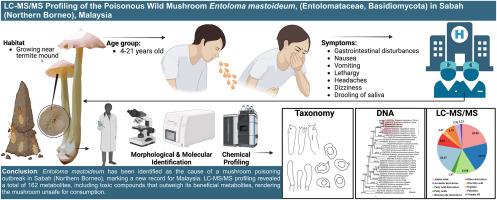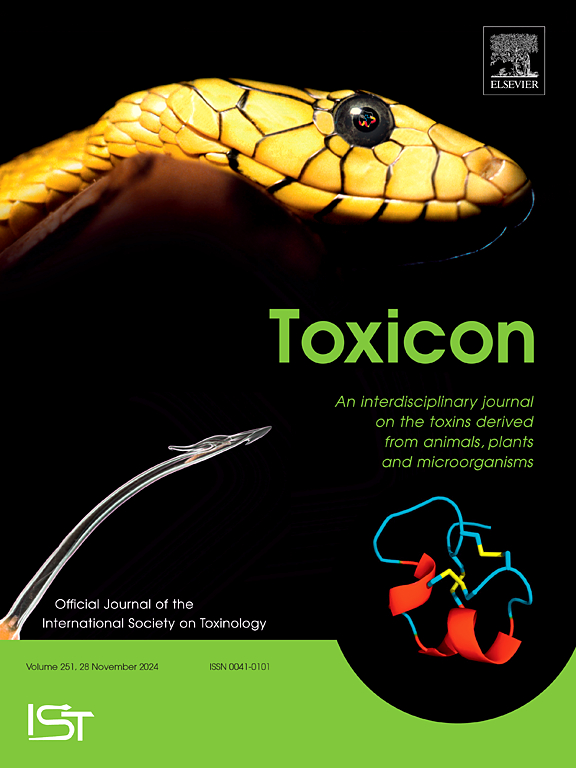马来西亚沙巴(北婆罗洲)有毒野生蘑菇 Entoloma mastoideum(Entolomataceae,Basidiomycota)的 LC-MS/MS 分析。
IF 2.6
4区 医学
Q2 PHARMACOLOGY & PHARMACY
引用次数: 0
摘要
在马来西亚,蘑菇中毒是一个重大的公共卫生问题,特别是当地社区经常食用野生蘑菇,却没有充分认识到它们带来的潜在危险。野生蘑菇与可食用蘑菇相似,但却含有致命的化学物质,摄入野生蘑菇是造成中毒风险的主要原因。Entoloma (Fr.) P. Kumm属蘑菇分布在世界各地,有记录的种类超过1500种。Entoloma mastoideum是马来西亚沙巴州哥打马鲁都区首次记录到的一种毒蘑菇,在2019年10月的雨季期间,该地区记录到了10起蘑菇中毒事件。研究人员记录了标本的形态特征,并使用复合显微镜和扫描电子显微镜分析了标本的显微特征。利用最大似然法和贝叶斯分析法构建了系统发生树。通过液相色谱质谱法(LC-MS/MS)对毒蘑菇标本进行了化学分析,以确定有毒代谢物。系统进化分析表明,婆罗洲的马氏蘑菇与中国的分离株关系密切(100% BS/1.0 PP)。LC-MS/MS 图谱共检测到 162 种代谢物,这些代谢物被分为十个大类,其中在芳香族化合物、必需氨基酸和脂肪酸衍生物中检测到了几种有毒化合物。据报道,在蘑菇提取物中发现的有毒化合物,包括氨基酸衍生物,如 3,4,5,6-四羟基炔亮氨酸、缬氨酸和甜菜碱,会导致神经毒性、心脏毒性、肝损伤和胃肠道损伤。这些有毒化合物的存在突出表明,食用野生蘑菇需要谨慎。对有毒 Entoloma 物种的进一步研究对于开发准确的鉴别方法和了解其毒性潜力至关重要。这些知识对于提高公众意识、预防蘑菇中毒事件和保障公众健康至关重要。本文章由计算机程序翻译,如有差异,请以英文原文为准。

LC-MS/MS profiling of the poisonous wild mushroom, Entoloma mastoideum, (Entolomataceae, Basidiomycota) in Sabah (Northern Borneo), Malaysia
In Malaysia, mushroom poisoning poses a significant public health concern, particularly as local communities frequently consume wild mushrooms without fully recognizing the potential dangers they present. Ingestion of wild mushrooms, which resemble edible species but contain deadly chemicals, is the main cause of poisoning risk. The genus Entoloma (Fr.) P. Kumm is dispersed worldwide, with over 1500 species recorded. Entoloma mastoideum, a poisonous mushroom, was recorded for the first time at Kota Marudu district, Sabah, Malaysia, where ten cases of mushroom poisoning outbreaks were recorded during the rainy season of October 2019. The morphological characters of the specimens were documented and their microscopic features were analyzed using compound microscope and scanning electron microscope. A phylogenetic tree was constructed using Maximum likelihood and Bayesian analysis. Chemical profiling of the poisonous mushroom specimen was done via liquid chromatograph mass spectrometry (LC-MS/MS) to identify toxic metabolites. The phylogenetic analysis showed that the Bornean E. mastoideum is closely related to the Chinese isolates (100% BS/1.0 PP). LC-MS/MS profiling detected a total of 162 metabolites that were classified into ten general groups, where several toxic compounds were detected amongst the aromatics, essential amino acids, and fatty acid derivatives. The toxic compounds identified in the mushroom extract, including amino acid derivatives such as 3,4,5,6-tetrahydroxyynorleucine, valpromide, and betaine, have been reported to cause neurotoxicity, cardiotoxicity, liver damage, and gastrointestinal harm. The presence of these toxic compounds underscores the need for caution when consuming wild mushrooms. Further research on poisonous Entoloma species is vital for developing accurate identification methods and understanding their toxic potential. This knowledge is essential for enhancing public awareness, preventing mushroom poisoning incidents and safeguarding public health.
求助全文
通过发布文献求助,成功后即可免费获取论文全文。
去求助
来源期刊

Toxicon
医学-毒理学
CiteScore
4.80
自引率
10.70%
发文量
358
审稿时长
68 days
期刊介绍:
Toxicon has an open access mirror Toxicon: X, sharing the same aims and scope, editorial team, submission system and rigorous peer review. An introductory offer Toxicon: X - full waiver of the Open Access fee.
Toxicon''s "aims and scope" are to publish:
-articles containing the results of original research on problems related to toxins derived from animals, plants and microorganisms
-papers on novel findings related to the chemical, pharmacological, toxicological, and immunological properties of natural toxins
-molecular biological studies of toxins and other genes from poisonous and venomous organisms that advance understanding of the role or function of toxins
-clinical observations on poisoning and envenoming where a new therapeutic principle has been proposed or a decidedly superior clinical result has been obtained.
-material on the use of toxins as tools in studying biological processes and material on subjects related to venom and antivenom problems.
-articles on the translational application of toxins, for example as drugs and insecticides
-epidemiological studies on envenoming or poisoning, so long as they highlight a previously unrecognised medical problem or provide insight into the prevention or medical treatment of envenoming or poisoning. Retrospective surveys of hospital records, especially those lacking species identification, will not be considered for publication. Properly designed prospective community-based surveys are strongly encouraged.
-articles describing well-known activities of venoms, such as antibacterial, anticancer, and analgesic activities of arachnid venoms, without any attempt to define the mechanism of action or purify the active component, will not be considered for publication in Toxicon.
-review articles on problems related to toxinology.
To encourage the exchange of ideas, sections of the journal may be devoted to Short Communications, Letters to the Editor and activities of the affiliated societies.
 求助内容:
求助内容: 应助结果提醒方式:
应助结果提醒方式:


